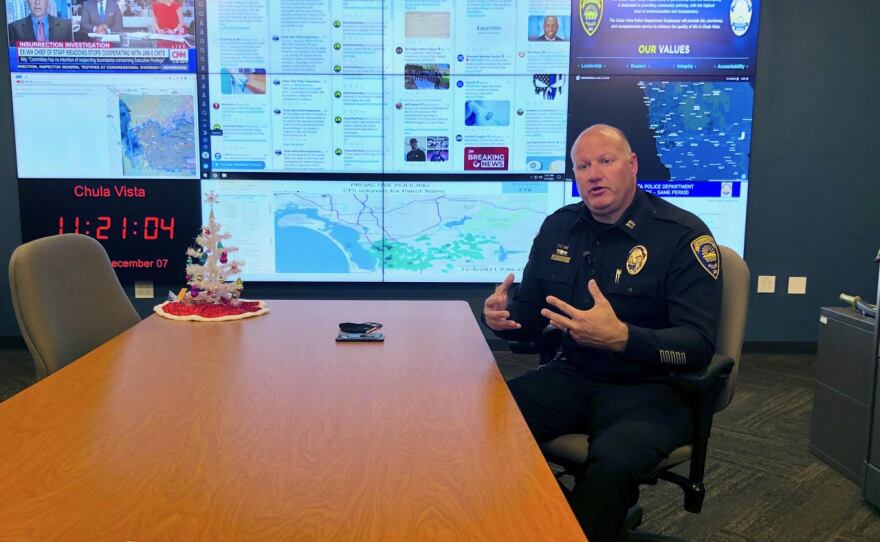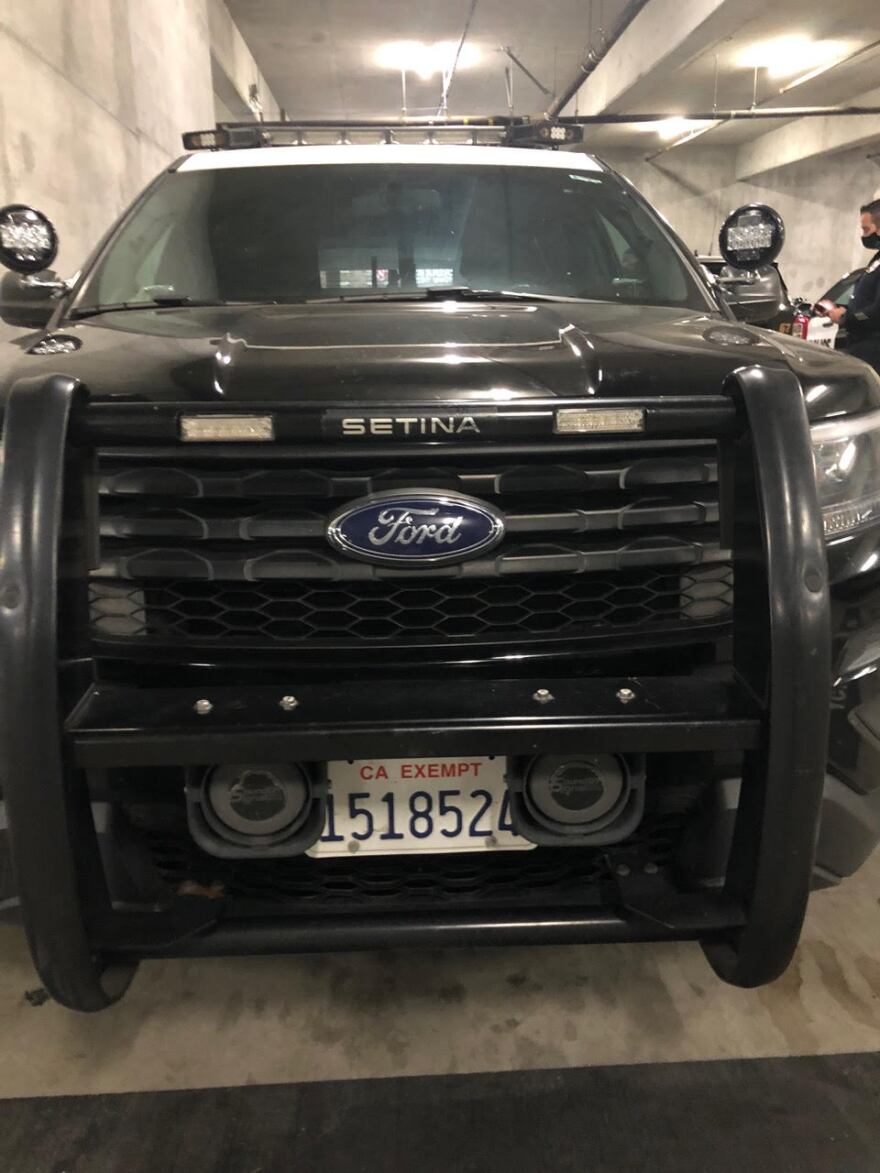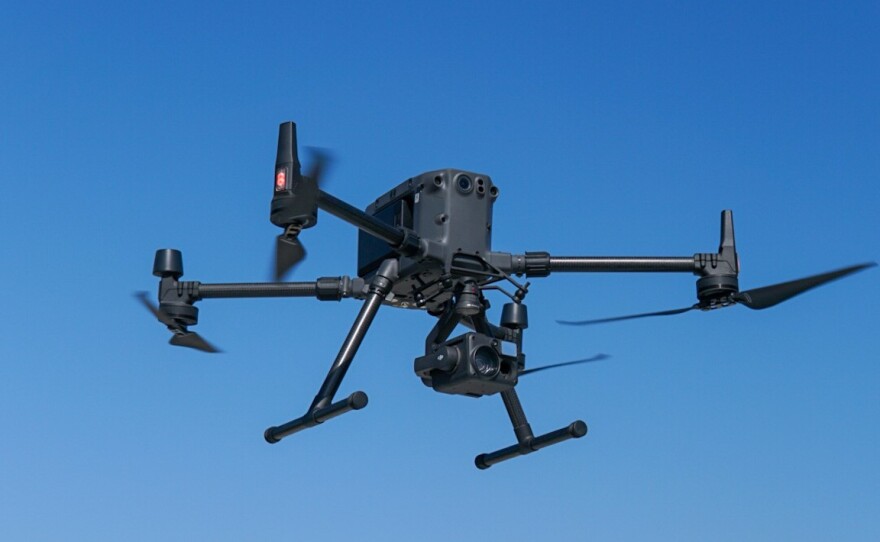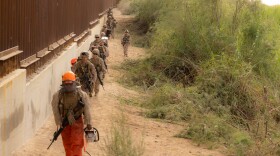Chula Vista has earned an unwelcome distinction.
“On a per capita basis, they're probably the most or one of the most surveilled cities in the country,” said Brian Hofer, executive director of the Oakland-based privacy advocacy group Secure Justice. “Pretty much the minute you walk outside your front door and move about your daily life, you're going to be tagged and tracked by some law enforcement agency, even though you've likely never been suspected of any wrongdoing.”
RELATED: Chula Vista Is Building A Real-Time Crime Center
Some of that surveillance is no different than what people in most American cities encounter everyday.
“Your cell phones are constantly pinging towers as you move around the city, revealing your location, your travel patterns and association,” Hofer said. “You could have facial recognition on all of the very many cameras you pass along the street and buildings.”
RELATED: Chula Vista Police Drones Can Now Cover 100% Of City For Emergency Calls
Chula Vista’s location adds federal surveillance to the mix. The city is just seven miles from the Mexico border, which opens it up to a network of monitoring by the nation’s largest law enforcement agency — the U.S. Customs and Border Protection.
The agency’s high-tech cache includes powerful drones, automated license plate scanners (ALPRs), facial recognition technology and surveillance towers with cameras, radars and infrared sensors, and surveillance blimps, according to the General Accounting Office and the nonprofit digital rights organization the Electronic Frontier Foundation.
”Border residents may never know that their information is being collected, but essentially, the government is able to put together a map of people's movements, either through incident times in which they're crossing the border itself, but also traveling through border communities,” said Shaw Drake, who serves as policy counsel for the ACLU’s Border Rights Center. “And so really, towns like Chula Vista, across the border, are subjected to more surveillance technology than anywhere else in the country.”
And there’s the Chula Vista Police Department’s own technological capacity, which has unsettled some locals.
They worry the agency’s signature drone program and automated license plate readers indiscriminately collect data on the innocent, disproportionately affect people of color and breach core American values. They want more scrutiny and oversight.
“We should have an expectation of privacy,” said Pedro Rios, director of the American Friends Service Committee’s U.S.-Mexico Border Program. “We should have an expectation that the police aren’t surveilling us with this type of enforcement technology when there isn't a reason to do so.”
Chula Vista city officials blame some of the criticism on a small group of “overly woke” residents and reiterate they themselves are well aware of the perils of embracing technology for technology’s sake.
“We don't just buy a shiny object to have it,” said Chula Vista Mayor Mary Salas. “Everything that we adopt is for a purpose. And it's been thoroughly vetted.”
Salas said the technology is meant to serve residents, not spy on them. And she is promising more oversight in the new year.
Drones as first responders
The Chula Vista Police Department deploys nine drones as first responders at a cost of about $1 million a year. Police live stream the drones’ scans for hazards at scenes for all kinds of 911 calls — murders, assaults, traffic accidents, missing people, trespassers, fires and natural disasters — before officers arrive. Police contend drones reduce response times, offer crucial details, help them make better decisions and diffuse tense situations.
“From a de-escalation perspective, there is no better tool in my mind,” said Chula Vista Police Capt. Eric Thunberg. “That to me is invaluable and I wish we had it years ago.”
The department’s website says police collect video and photos from drone flights — to the scene and on the way back — which are “generally accessible to police investigators for official use only.” The footage is stored for one year unless it’s connected to an ongoing investigation.

The department also has another handful of drones that it uses for executing search warrants or finding missing people in hard-to-get to places. Those drones are automated and have the capacity to follow people in and out of buildings, Thunberg said.
“We use them in more tactical environments,” he said. “They keep our officers out of danger.”
The Chula Vista Police Department is one of more than 1,500 state and local public safety agencies in the country with drones, according to 2020 data collected by Bard College researchers.
The department claims it was the first in the country to win FAA approval to fly all over the 52-square-mile city.
Thunberg said department officials met with the ACLU and residents to address concerns before the drones took off from the department’s roof for their maiden flight in 2018. The goal was to assure people that the department would use the technology responsibly.
“We’re not going to do things that are not good for our community,” Thunberg said.
But civil libertarians still believe police drones can violate the privacy rights of the innocent.
“They can reach places that are actually very difficult for people to access without a warrant,” said ACLU attorney Mitra Ebadolahi. “A drone may be able to look in on a backyard that's otherwise not publicly visible, where someone may have a reasonable expectation of privacy under the Fourth Amendment. A lot of really important questions about our privacy rights and the Constitution remain unanswered.”
“A drone may be able to look in on a backyard that's otherwise not publicly visible, where someone may have a reasonable expectation of privacy under the Fourth Amendment. A lot of really important questions about our privacy rights and the Constitution remain unanswered.”Mitra Ebadolahi, ACLU attorney
Privacy advocates argue equally troubling is that people have no way of knowing if drones have gathered footage on them or their property.
Thunberg argues these concerns have been addressed.
“Those drones, when they’re flying from A to B, that camera lens is horizontal, it’s not vertical,” he said.
But once on the scene and the cameras tilt downward, the drones can still capture details of nearby private property that are not part of the 911 call.
License plate readers and broken trust
Back in 2020 at the Chula Vista Police Department, Capt. Don Redmond made clear that the effective use of police technology relied on residents’ faith in the department.
“The community allows us to protect them because they trust us,” Redmond said. “As soon as we break that trust, they become issues.”
Late last year it was revealed that Chula Vista police shared data collected from its license plate readers with immigration officials. This technology, commonly referred to as ALPRs (Automated License Plate Readers), takes photos of license plates and includes the time the picture was captured and the location of the vehicle.
Rios, of the American Friends Service Committee, said sharing that data with federal officials belies Chula Vista’s designation as a Welcoming City for immigrants as well as state law known as SB 54, which prohibits local and state resources from aiding in federal immigration enforcement.
“The bigger question there for me is not only about the impact that it might have on our migrant community members and neighbors, but also the slippery slope around our civil liberties,” said Rios, who also lives in Chula Vista.
Chula Vista police have since said they stopped sharing the data with ICE and Border Patrol in April of this year.
Police Chief Roxana Kennedy has been contrite. “In retrospect, we regret not looking at this more thoroughly,” Kennedy said at a Chula Vista City Council meeting in April.
The Chula Vista Police Department still shares ALPR data for specific investigations only with other California law enforcement agencies, bound by state law from helping immigration officials. Thunberg said there are safeguards and laws, both for personnel and agencies that misuse or abuse their authority when it comes to data sharing.
“There are no absolutes,” he said. “People do the wrong thing sometimes. Sometimes those people are police officers. I can’t speak to other agencies, but we work hard to ensure our personnel understand the law, our mission and culture and always strive to do right.”

Advocates contend that license plate readers treat everyone as suspects and want the department to stop using them.
A new study by the nonpartisan public policy group The Independent Institute in Oakland, found that 16 years of data from the Piedmont Police Department revealed no evidence that ALPRs give law enforcement investigative leads, deter vehicle theft or help recover stolen vehicles.
Rios cites the Chula Vista Police Department’s own statistics showing a hit rate of less than 1% with vehicles tied to suspected crimes, mostly in western Chula Vista, where many of the city’s poor and people of color live.
“It makes me wonder when police are checking out the vehicle that contains the ALPR technology if they are purposefully using it only in one community of the city of Chula Vista,” Rios said.
To that, Thunberg told KPBS that the police department is “committed to partnering with the community and serving with professionalism.”
“We deploy our resources based on the demand for our services,” Thunberg said.
He also suggested that the low number of hits from its license plate readers might partly be due to the fact that the city only has four of the devices. He added that hits are just one feature of ALPRs.
“The ALPR system is an investigative tool,” Thunberg said. “It allows our investigators the opportunity to see if a vehicle of interest was at or near the scene of a crime. With the lowest staffed department in the county and one of the lowest in the state, we can better serve victims of crime in our city by using ALPRs to solve crimes.”
And Chief Kennedy has said that the double digit rise in murders, assaults and robbery in the city this year underscores the need for the technology.
“There have been countless success stories where the ALPR program has played a pivotal role in solving crimes and in keeping our community safe,” she said earlier this year.
New operations center
In spite of public concern, Chula Vista police officials are moving ahead on plans to integrate the data the department gathers. The agency is building a real-time operations center. It will sew together different surveillance networks and information, like jail records, to keep watch over what’s happening in the city, gather intelligence and solve crimes.
“This results in decision-quality data reaching the officers on scene and can lead to quicker and safer incident resolutions.” Thunberg said.
The brightly lit center sits on the first floor of the agency’s headquarters in downtown Chula Vista. One wall is plastered with a bank of 12 screens that livestream drone footage, display 911 calls and show the whereabouts of on-duty officers. The center also has access to ALPR data and shows the latest social media reports of illegal activity in the city.
“It allows us to have everything at our fingertips at one place,” Thunberg said.
But privacy advocates say police departments intentionally downplay the cutting edge technology at these centers by claiming they are only compiling existing resources in a central location.
“It’s intentionally obfuscating the reality of how this is quite different from mere piecemeal data collection,” ACLU lawyer Mitra Ebadolahi said.
She said one piece of data obtained on an individual in isolation is likely innocuous. But when data is mined from disparate sources, assembled and analyzed, profiles develop. Some of these may be of innocent people.
“The ALPR system is an investigative tool. It allows our investigators the opportunity to see if a vehicle of interest was at or near the scene of a crime. With the lowest staffed department in the county and one of the lowest in the state, we can better serve victims of crime in our city by using ALPRs to solve crimes.”Eric Thunberg, Chula Vista Police captain
“And so someone who has not committed any kind of wrongdoing is nonetheless a part of the information that is seeding a real time crime center,” Ebadolahi said. “There's no individualized suspicion that justifies that kind of attention on that individual. And there's also no way of knowing the extent to which that individual's information is in the system and how often it's queried and whether or not there are adverse consequences for that person as a result.”
Advocates like Ebadolahi and Rios have also raised concerns about crime centers enabling “predictive policing” — which uses data to forecast crime. Recent reports show the bias in some of these predictive policing technologies.
“They disproportionately target Black people and people of color,” said Ebadolahi. “They disproportionately predict criminality in people of color.”
Motorola Solutions, which has built the operations center for the Chula Vista Police Department, asserts in documents that the facility has the capacity to do analytics, facial recognition and AI. Thunberg said the department does not intend to activate those features.
The department has expressed a desire to incorporate predictive policing in its five year strategic plan. But Thunberg emphasized that the department’s operations center will not add additional data mining capacity or predictive policing without public discussion.
“That’s not something that we’re just going to flip a switch and turn on,” Thunberg said. “If we have it down the road, it will be because we vetted it with the community.”
Calls for more oversight
Civil rights activists in Chula Vista have pushed for more scrutiny of police surveillance tools.
“There needs to be an independent body overseeing the police department’s use of technology,” said Ricardo Medina, a member of Chula Vista’s Human Relations Commission. “It needs to have people who understand technology, its privacy consequences, its effectiveness and how to measure it, not through anecdotes, but through hard evidence.”
Chula Vista city officials say they are working on creating an oversight commission on police technology use. The hope is that the new body will draft a privacy policy on law enforcement surveillance tools.
Thunberg said he looks forward to receiving input from the panel.
“We value that because that’s how we get better,” said Thunberg, adding the department will be involved. “We’ll be a part of that and be a player.”
As a private citizen, Thunberg said he is untroubled by new police technology
“I’m not doing anything wrong,” he said. “I’m not worried about being watched or followed. I don’t have anything to hide.”
Hofer argued that’s precisely the wrong way to look at the issue.
“It’s not that we have nothing to hide but that we all have something to protect,” Hofer said.
ACLU lawyer Ebadolahi said it’s a message that should resonate with private citizens.
“If you aren’t already, this is the time to take privacy seriously because we are witnessing a rapid proliferation of these technologies,” Ebadolahi said. “These technologies just keep building on each other and we end up with a massively surveilled community which is just inconsistent with living in a free society. You start to look like a police state.”
But Mayor Salas said she is confident that ultimately Chula Vista residents will be “satisfied” that the city’s policing technology are tools to solve crimes, not watch people for no reason.
“I love my police, and I know that they're doing the right thing, and they come from the right attitude,” she said.
-
A combination of federal, municipal and private tracking systems has turned the border city of Chula Vista into one of the most surveilled cities in the country, according to privacy advocates. Now a new high tech operations center for the local police department will work to integrate all the data coming in from police activities.
-
Border artist Michelle Guerrero struggled with addiction for years, but a surprise pregnancy helped her straighten out her life. Eventually, she taught herself how to paint large-scale murals, in part, by painting murals on the actual border fence. These days, she goes by Mr B Baby, and she travels the West Coast and Mexico, painting huge Mexican-inspired murals in a style that is her own.








